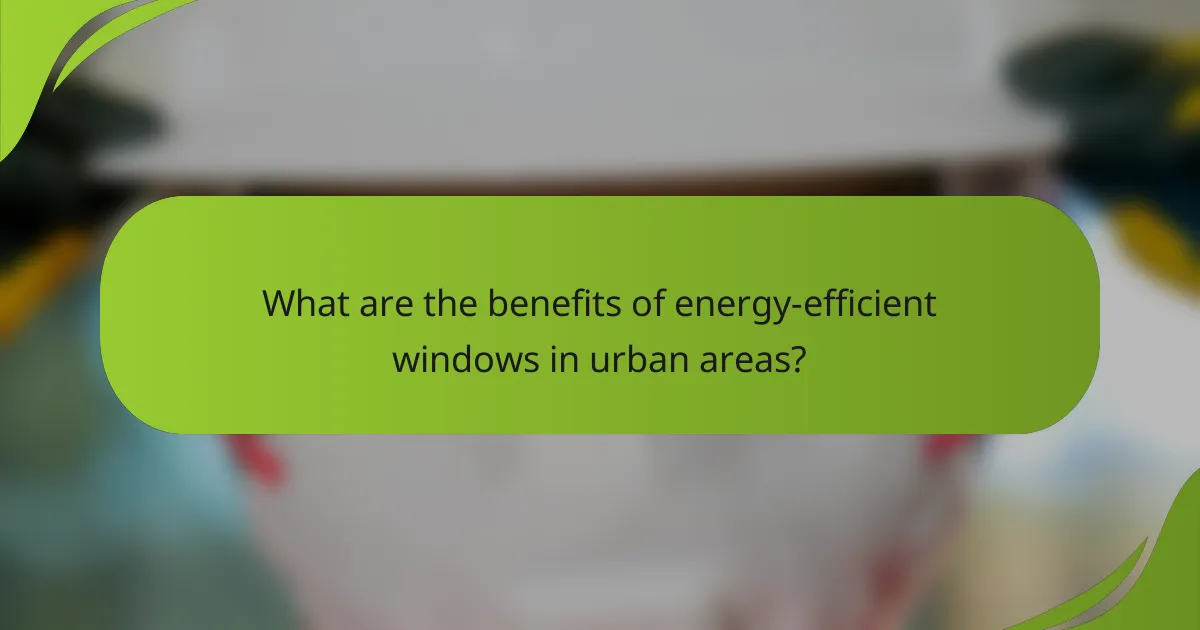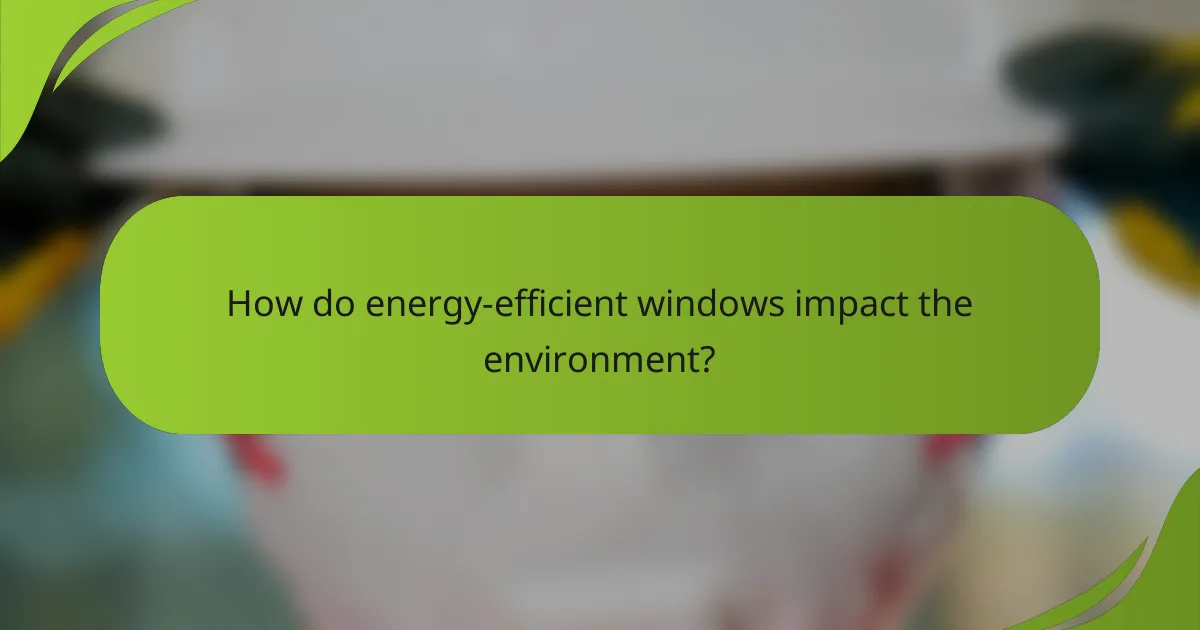Energy-efficient windows are designed to provide superior insulation, UV protection, and noise reduction compared to standard windows, making them an essential upgrade for homeowners. By minimizing energy loss and maintaining stable indoor temperatures, these windows not only enhance comfort but also lead to significant energy savings over time. Although the initial investment may be higher, the long-term benefits often outweigh the costs, resulting in improved living conditions and increased home value.

What are the benefits of energy-efficient windows in urban areas?
Energy-efficient windows offer significant advantages in urban areas by reducing energy consumption and enhancing overall comfort. These windows help maintain a stable indoor temperature, leading to lower energy costs and improved living conditions in densely populated settings.
Lower energy bills
One of the primary benefits of energy-efficient windows is their ability to lower energy bills. By minimizing heat transfer, these windows can reduce heating and cooling costs by up to 30% compared to standard windows. This translates to savings of hundreds of dollars annually, depending on local energy prices.
When selecting energy-efficient windows, look for those with a low U-factor and high Solar Heat Gain Coefficient (SHGC). These ratings indicate better insulation and reduced energy loss, which are crucial for urban homes facing varying weather conditions.
Improved indoor comfort
Energy-efficient windows significantly enhance indoor comfort by maintaining a consistent temperature throughout the year. They reduce drafts and cold spots, making living spaces more enjoyable. This is particularly important in urban areas where external noise and temperature fluctuations can be more pronounced.
Additionally, these windows often feature advanced glazing technologies that minimize glare and block harmful UV rays, further contributing to a comfortable indoor environment. Homeowners should consider double or triple-glazed options for optimal performance.
Enhanced property value
Investing in energy-efficient windows can increase property value, making homes more attractive to potential buyers. Properties with energy-efficient features often sell faster and at higher prices, as buyers increasingly prioritize sustainability and lower utility costs.
In urban markets, where competition is fierce, having energy-efficient windows can set a property apart. Homeowners should keep records of energy savings and improvements to showcase the benefits during the selling process.

How do energy-efficient windows compare to standard windows?
Energy-efficient windows significantly outperform standard windows in terms of insulation, UV protection, and noise reduction. These windows are designed to minimize energy loss, protect interiors from harmful sunlight, and reduce external noise, making them a valuable investment for homeowners.
Insulation performance
Energy-efficient windows are built with advanced materials and technologies that enhance insulation performance. They typically feature multiple panes of glass, low-emissivity (Low-E) coatings, and gas fills like argon or krypton, which help to reduce heat transfer. This can lead to energy savings of around 10-25% on heating and cooling costs compared to standard windows.
When selecting windows, look for those with a lower U-factor, which indicates better insulation. Energy Star ratings can also guide you in choosing windows that meet specific energy efficiency criteria, ensuring optimal performance in your climate.
UV protection
Energy-efficient windows provide superior UV protection compared to standard windows, thanks to their Low-E coatings. These coatings can block a significant percentage of harmful ultraviolet rays, which can fade furniture, flooring, and artwork. Standard windows often allow most UV rays to pass through, leading to quicker deterioration of interior items.
For homeowners, investing in energy-efficient windows can help preserve the aesthetic and value of your home by reducing UV damage. Look for windows that specify their UV-blocking capabilities to ensure adequate protection.
Noise reduction
Energy-efficient windows excel in noise reduction, making them ideal for homes in busy or noisy areas. The combination of multiple glass panes and insulating frames helps to dampen sound transmission, providing a quieter indoor environment. In contrast, standard windows often allow more noise to enter, which can be disruptive.
When considering noise reduction, check the Sound Transmission Class (STC) rating of the windows. Higher STC ratings indicate better sound insulation, helping you choose the right windows for your specific noise concerns.

What are the costs of energy-efficient windows in the United States?
The costs of energy-efficient windows in the United States typically range from a few hundred to over a thousand dollars per window, depending on various factors such as materials, installation, and energy ratings. While the initial investment is higher than standard windows, the long-term benefits often justify the expense through energy savings and increased home value.
Average installation costs
The average installation costs for energy-efficient windows can vary significantly, generally falling between $300 and $1,000 per window. This price range includes both the window itself and the labor required for installation. Factors influencing these costs include the type of window frame, glazing options, and the complexity of the installation process.
For example, vinyl windows tend to be more affordable, while wood or fiberglass options may command higher prices. Homeowners should obtain multiple quotes to ensure competitive pricing.
Long-term savings
Investing in energy-efficient windows can lead to substantial long-term savings on energy bills, often reducing heating and cooling costs by 10% to 25%. These windows are designed to minimize heat transfer, keeping homes warmer in winter and cooler in summer.
In addition to energy savings, many states offer tax credits or rebates for homeowners who upgrade to energy-efficient windows, further enhancing the financial benefits. Over time, these savings can offset the initial higher costs of installation.
Financing options
Homeowners looking to install energy-efficient windows have several financing options available. Many window manufacturers and retailers offer financing plans that allow for monthly payments, making the upfront costs more manageable. Additionally, some local and federal programs provide low-interest loans or grants specifically for energy-efficient home improvements.
Before committing to a financing option, it’s wise to compare interest rates and terms. Homeowners should also consider whether the monthly payments align with their budget and how quickly they expect to see savings on their energy bills.

What factors should you consider when choosing windows?
When selecting windows, consider energy efficiency, climate, materials, and local building codes. These factors impact not only comfort and utility costs but also compliance with regulations and the longevity of your investment.
Climate considerations
Your local climate significantly influences the type of windows you should choose. In colder regions, energy-efficient windows with high insulation values help retain heat, while in warmer climates, windows that reflect sunlight can reduce cooling costs.
Consider the seasonal temperature variations in your area. For example, regions with harsh winters may benefit from double or triple-glazed windows, while milder areas might only require standard double-glazing.
Window materials
The materials used in window frames affect both energy efficiency and durability. Common materials include vinyl, wood, fiberglass, and aluminum, each offering different insulation properties and maintenance needs.
Vinyl frames are often favored for their low maintenance and good insulation, while wood frames provide excellent thermal performance but require more upkeep. Choose materials that align with your climate and aesthetic preferences.
Local building codes
Local building codes dictate specific requirements for window installations, including energy efficiency standards and safety regulations. Familiarize yourself with these codes to ensure compliance and avoid potential fines or issues during inspections.
For instance, some regions may require windows to meet certain energy performance ratings, such as those set by the Energy Star program. Always check with local authorities or a professional contractor to ensure your choices meet these regulations.

How do energy-efficient windows impact the environment?
Energy-efficient windows significantly reduce environmental impact by minimizing energy consumption and lowering greenhouse gas emissions. By enhancing insulation and reducing heat transfer, these windows contribute to a more sustainable living environment.
Reduced carbon footprint
Energy-efficient windows help decrease the carbon footprint of buildings by lowering the amount of energy required for heating and cooling. This reduction in energy use translates to fewer emissions from power plants, which often rely on fossil fuels.
For example, homes equipped with energy-efficient windows can reduce their carbon emissions by a notable percentage, depending on the climate and energy sources used. Choosing windows that meet ENERGY STAR® standards can further enhance these benefits.
Energy conservation
Energy conservation is a primary advantage of energy-efficient windows, as they help maintain indoor temperatures with less reliance on heating and cooling systems. This efficiency not only saves energy but also reduces utility bills, making it a financially sound choice for homeowners.
On average, energy-efficient windows can save households tens of percent on energy costs annually. When selecting windows, look for features such as low-emissivity (Low-E) coatings and multiple glazing to maximize energy conservation.
